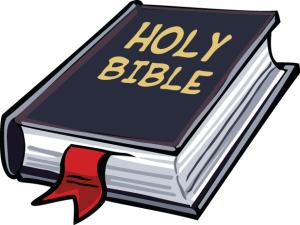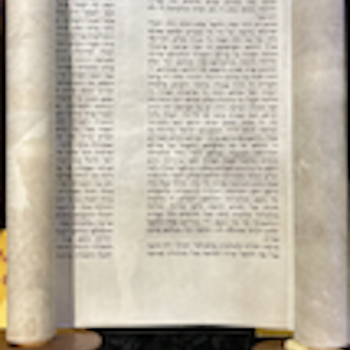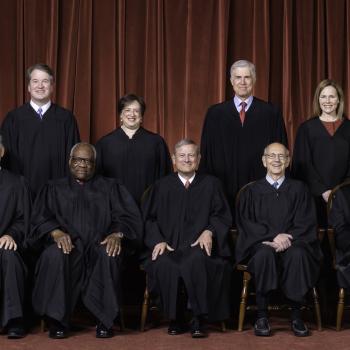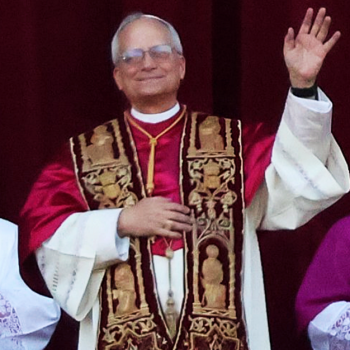One of the most important texts in the Bible is Daniel 7.9-14, and it contains perhaps the greatest revelation of Jesus in the Bible. But we need to get the background first.
Daniel first relates, “In the first year of King Belshazzar of Babylon, Daniel had a dream and visions of his head as he lay in bed. Then he wrote down the dream” (Daniel 7.1). In vv. 2-8, Daniel records this dream which is one of the most significant prophecies in the Bible. It corresponds to a dream recorded in Daniel 2 which King Nebuchadnezzar had. Both predict four great, Mediterranean empires culminating in “the end of days,” meaning the age of this age. I believe they were the Neo-Babylonian, Media-Persian, Greek, and Roman empires.
(I believe the book of Daniel was not written in the 2nd c. BCE but in the 6th c. BCE as Jews always believed. And I am quoting throughout from the New Revised Standard Version of the Bible, which is considered the first choice of Bible scholars.)
Then Daniel 7.9-10 reads, “As I watched, thrones were set in place, and the Ancient One took his throne, his clothing was white as snow, and the hair of his head like pure wool; his throne was fiery flames, and its wheels were burning fire. A stream of fire issued and flowed out from his presence, a thousand thousands served him, and ten thousand times ten thousand stood attending him. The court sat in judgment.”
In this dream-vision, the Ancient One (actually, “Ancient of Days”) is God. Those attending him are his holy angels. A huge amount of discussion has taken place throughout history among especially Jews, but also Christians, about “thrones were set, and an Ancient One took his throne.” There have been various interpretations of it. Some have thought only God sat on his throne and “thrones” were only for his feet. But the most prominent interpretation among Jews for a time was that only two thrones are involved, with the extra throne being for “Metatron.” This supposed angel is not mentioned in the Jewish Bible, but some rabbis viewed him as a special angel who was honored alongside God. But this viewpoint seemed to encroach on Jewish monotheism.
Another Jewish view was that “thrones” also referred to God’s throne and one other throne, and the latter throne belonged to the Messiah. During the second century CE, Rabbi Akiva claimed a Judean warrior named Simon bar Kokhba was the promised Messiah and that this extra throne in Daniel 7.9 belonged to him. Due to this endorsement, it caused Jews to revolt against the Roman Empire in what is called the Bar Kokba Revolt or Second Jewish Revolt that occurred in 132-135. The Roman armies were victorious in putting it down, with Simon and Akiva being killed. The Romans then banned Jews from living in Jerusalem, and thus began the Diaspora.
I disagree with these interpretations of Daniel 7.7-9. Instead, I believe “thrones” are other than God’s “throne.” So, I align myself with that interpretation of it held by New Testament scholar Richard Bauckham and others. It is that the “thrones” in Daniel 7.9 are other than God’s throne and belong to “the twenty-four elders” who are mentioned repeatedly in the New Testament’s last book, the book of Revelation. John the author first relates about them, “I was in the spirit, and there in heaven stood a throne, with one seated on the throne! . . . Around the throne are twenty-four thrones, and seated on the thrones are twenty-four elders, dressed in white robes, with golden crowns on their heads” (Revelation 4.2-4). These twenty-four elders comprise God’s heavenly council of holy angels.
Many Christians don’t know that the Bible informs about God having a council of holy angels with which he meets in heaven, apparently on a regular basis. They meet to discuss matters and oftentimes make decisions to do something. Perhaps the most memorable time that this happened is recorded in the book of Job, which is part of the Bible’s wisdom literature. It soon relates, “One day the heavenly beings came to present themselves before the LORD, and Satan also came among them” (Job 1.6). God and Satan then discussed the righteous man Job on earth. Then begins the narrative of how God allowed Satan to bring trials into Job’s life as a test to see if he would curse God or remain faithful to him. Sometime later the same thing happened again in heaven, “One day the heavenly beings came to present themselves before the LORD, and Satan also came among them to present himself before the LORD” (Job 2.1).
The Old Testament has a few other texts which depict God meeting with his holy council in heaven. One such council meeting was in the days of Elijah the prophet and wicked King Ahab of Israel and his Queen Jezebel. The prophet Micaiah relates, “I saw the LORD sitting on his throne, with all the host of heaven standing beside him to the right and to the left” (1 Kings 22.19). They discussed King Ahab and what to do about him. We read, “And the LORD said, ‘Who will entice Ahab, so that he may go up and fall at Ramoth-gilead?” in battle (v. 20). A “spirit,” likely an angel, “came forward and and stood before the LORD, saying, ‘I will entice him.’ How? the LORD asked him. He replied, ‘I will go out and be a lying spirit in the mouth of all his prophets.’ Then the LORD said, ‘You are to entice him, and you shall succeed; go out and do it'” (vv. 21-22). Prophets advised kings about whether to conduct wars.
Another instance is the psalmist writing, “Let the heavens praise your wonders, O LORD, your faithfulness in the assembly of the holy ones. For who in the skies can be compared to the LORD? Who among the heavenly beings is like the LORD, a God feared in the council of the holy ones, great and awesome above all that are around him?” (Psalms 89.5-7).
Daniel then has another vision he records in Daniel 7.13-14. It is a royal ceremony scene in heaven. Both the court scene and this royal ceremony scene actually will happen in heaven at the end of the age. The court proceeding will occur first to be followed soon by the royal ceremony. Daniel 7.13-14 reads, “I saw one like a human being coming with he clouds of heaven, and he came to the Ancient One and was presented before him. To him was given dominion and glory and kingship, that all peoples, nations, and languages should serve him. His dominion is an everlasting dominion that shall not pass away, and his kingship one that shall never be destroyed.”
During Jesus’ public ministry, people were constantly wondering if he was the Messiah of Israel promised in its Scriptures (e.g., John 7). But Jesus did not go around proclaiming he was the Messiah. Actually, it was just the opposite; he often told people not to broadcast that he was the Messiah (e.g., Matthew 16.20; 17.9). Scholars calls this phenomena the Messianic Secret.
But Jesus constantly identified himself as “the Son of Man.” Scholars argue about whether he did so on the basis of Daniel 7.13-14, and I believe he did. In fact, Jesus constantly taught in parables about the kingdom of God, and I believe he gained his primary understanding about it from this text. Christians traditionally have interpreted this figure as Jesus, and I think that is correct. However, modern scholars have not. Many have interpreted it as an angel, such as Michael or the archangel, Metatron, or “the angel of the LORD. But perhaps the most prominent interpretation among them has been the so-called “Jewish interpretation,” which is that this Son of Man figure does not refer to an actual personage but is a symbol referring to the Jewish saints of the end times.
Actually, I think the NRSV has taken an unwarranted liberty in translating the Aramaic text ke-bar nash in Daniel 7.13 as “one like a human being.” It is translated literally “one like a son of man.” That is how almost all English versions of the Bible translate it, and I think that’s the way it should be translated. Why? Bar means “son,” ke means “like,” and nash is the shortened form of enash, which means “man” or a “human being.” But the NRSV and the NRSVue translated it as above, “one like a human being.” I believe this translation loses an important meaning of ke-bar nash, which is that it refers to Jesus virgin birth.
The NRSV translating ke-bar nash in Daniel 7.13 as “one like a human being” suggests that Jesus was not a human being. That, of course, is wrong and plays into the hands of Gnosticism. Rather, Jesus was not a “son of man” but “like” a “son of man” because he had a virginal conception by the power of the Holy Spirit and thereby had a virgin birth (Luke 1.26-35). Thus, the Aramaic word ke, meaning “like,” indicates Jesus’ virgin birth. As for Jesus often applying the expression “Son of Man” to himself, rather than “one like a son of man,” in Jewish usage, as affirmed especially in the non-canonical book 1 Enoch, which was written in the 2nd or 1st century BCE, “Son of Man” became a shortened form of “one like a son of man” in Daniel 7.13.
I’m unaware of any scholars who teach this–about ke-bar nash in Daniel 7.13 indicating Jesus’ virgin birth–so I put forth this interpretation somewhat tentatively.














